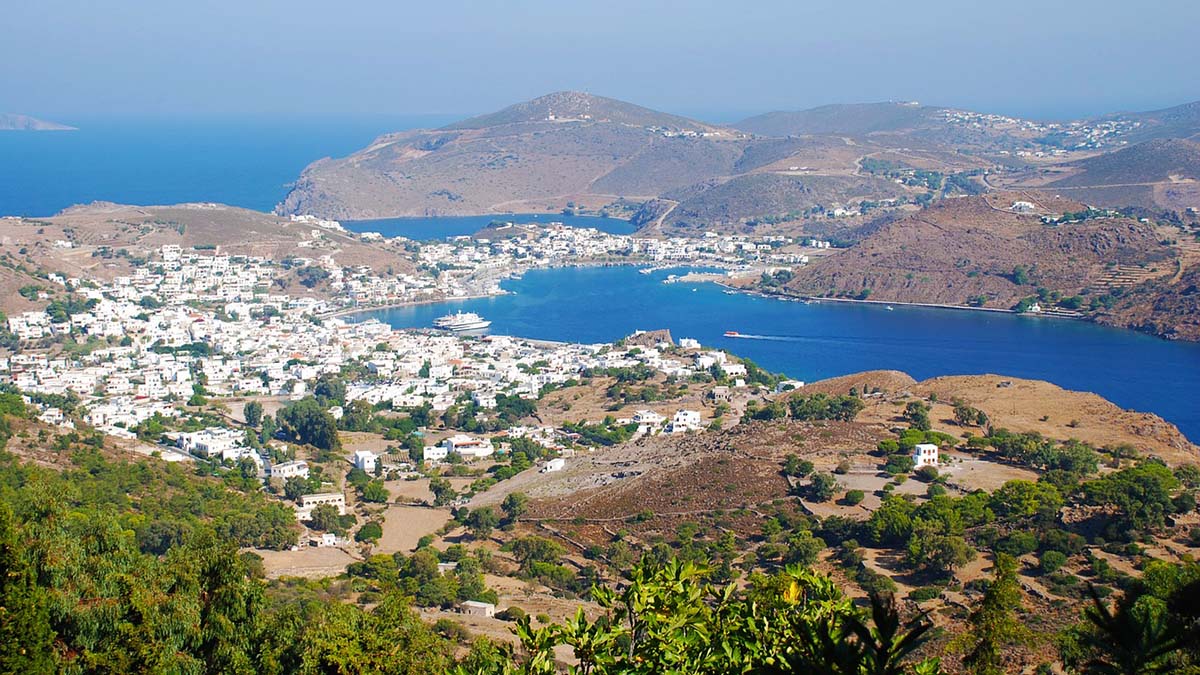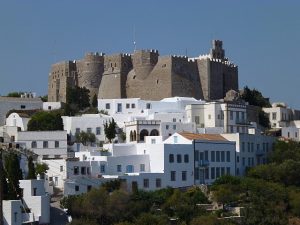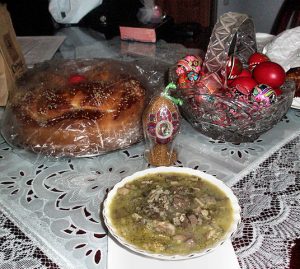
by W. Ruth Kozak
The funeral bells have been tolling since early morning and the flags are flying at half-staff. It is a day of mourning: Good Friday on the island of Patmos.
As we climb the hill from the port to the Church of the Apocalypse, the sound of fireworks crackles like gunfire, resounding across the pastoral hills. The goats graze among the profusion of wildflowers and stop to stare at us with their curious yellow eyes. Far across the valley, a donkey brays.
 This is the island where 2,000 years ago the disciple John, known as St. John the Evangelist, was exiled by the Romans for preaching Christianity in Asia Minor. Just below the tiny white-domed Church of the Apocalypse is the cave where the apostle lived. The cave is sheltered beneath the small chapel and we are reminded, as we enter it, that it is a sacred place. It was here, in this awe-inspiring place, that John received the terrifying visions described in his book of the Apocalypse, known as Revelation. The cave is a place of meditation and is preserved as a reminder of the struggle between good and evil.
This is the island where 2,000 years ago the disciple John, known as St. John the Evangelist, was exiled by the Romans for preaching Christianity in Asia Minor. Just below the tiny white-domed Church of the Apocalypse is the cave where the apostle lived. The cave is sheltered beneath the small chapel and we are reminded, as we enter it, that it is a sacred place. It was here, in this awe-inspiring place, that John received the terrifying visions described in his book of the Apocalypse, known as Revelation. The cave is a place of meditation and is preserved as a reminder of the struggle between good and evil.
Patmos, a small island with about 2,000 residents, is one of the Greek Dodecanese Islands near the Turkish coast. It was once noted for its shipbuilding and trade and many of the traditional mansions have been restored. Today Patmos is known mainly for the Monastery of St. John the Theologian and for the pilgrimage at Easter, which attracts visitors from all over the world.
Back at the port village of Skala, the funeral processional has just begun. The epitafios, a small casket decorated with red and white carnations and icons of Christ, is borne by men of the village. This casket symbolizes the body of Christ. The processional is led by the priests, resplendent in rich ceremonial robes. They are followed by solemn young altar boys holding candles and crucifixes. As the casket is carried through the village, a Byzantine icon depicting the crucifixion is held aloft on a wooden cross wreathed with flowers. The narrow streets are lit by candlelight and the glittering gold of the relics. The heady fragrance of incense wafts from the censers, fanning out over the throng. As the priest begins to chant the litanies, a men’s choir harmonizes the story of the crucifixion. This is the beginning of the religious holiday that in Greece is celebrated with more pageantry than Christmas.
 The crack of fireworks and the chiming of church bells awaken us the next morning. We walk along the quay. In the harbor, the fishermen are setting out in their turquoise and red caiques. The calm sea is a luminous, dark blue. From the green hills behind Skala drifts the fragrance of wild roses and herbs. There is a serenity on Patmos that you will see reflected on the faces and in the attitudes of the Patmians who have preserved the dignity of this “holy island”.
The crack of fireworks and the chiming of church bells awaken us the next morning. We walk along the quay. In the harbor, the fishermen are setting out in their turquoise and red caiques. The calm sea is a luminous, dark blue. From the green hills behind Skala drifts the fragrance of wild roses and herbs. There is a serenity on Patmos that you will see reflected on the faces and in the attitudes of the Patmians who have preserved the dignity of this “holy island”.
Looming above the village of Chora and the port of Skala is the Monastery of the Theologian. The monastery was founded 900 years ago. Some of the richest treasures of Greece are kept here including priceless icons, vestments and parchment manuscripts.
In the monastery chapel, a crowd has gathered, spilling out into the courtyard. The cobblestones are strewn with branches of hyssop. Its purifying fragrance mingles with the scent of incense and beeswax candles. A monk begins a rhythmic hammering on a long wooden beam suspended in the entrance of the chapel. This beating of the talanton symbolizes the risen Christ and heralds the beginning of the Easter mass.
At midnight, as the bells begin to peal, the monks and priests file out of the chapel to join the throng of worshipers. As the pappas announces the joyous proclamation: “Christos Anesti! Christ is Risen!” his words are echoed in unison by the worshipers. He touches the flame of his altar candle to the wicks of the slender tapers held by each celebrant. One by one the flame is passed on, until all the candles are lit and the courtyard blazes with light.
For the children it’s time to collect the brightly colored eggs distributed by the priest. These red eggs, polished with oil until they shine with a wax-like finish, are symbols of the blood of Christ. The children play a game, tapping the ends of the eggs together to see whose is the last to break.
 Now the celebration is over and we follow the celebrants through the streets of the village as they carry their lighted candles home. Each flame is carefully protected until it scorches a cross above the lintel of the doorway. This will ensure good fortune and God’s blessing for the year.
Now the celebration is over and we follow the celebrants through the streets of the village as they carry their lighted candles home. Each flame is carefully protected until it scorches a cross above the lintel of the doorway. This will ensure good fortune and God’s blessing for the year.
At a taverna in Chora, we dine on roast lamb and mageritsa, the traditional soup made of lamb’s innards eaten by the Greeks at Easter. The meal is followed by lambropsomo, a sweet Easter bread decorated with red eggs placed in the centre to form the tips of a cross.
We walk the four kilometres down the dark road through the cypress groves to the port. On the edge of the bay someone has set off a red flare which fans out over the harbor, illuminating the fish boats in their moorage. Down on the beach, one last rocket hisses and whines. Then all is quiet. The trace of gunpowder smoke lingers in the air. But there is a spirit of peace on Patmos.
Editor’s note: In 2021 Greek Orthodox Easter is Sunday, May 2nd.
If You Go:
Ferries leave daily from the port of Pireaus.
More Information: Patmos Island
Greek National Tourism Organisation
About the author:
W. Ruth Kozak has spent many years living in and visiting Greece. One of her favorite times of year there is Easter time. The celebrations, rich in tradition, are an unforgettable experience for the traveler to Greece. Her website is www.ruthkozak.com
Photo Credits:
Patmos Island by EzPzPics from Pixabay
Patmos Monastery of St John by Valeria Casali / CC BY-SA
Traditional Greek Orthodox Easter Food by ΙΣΧΣΝΙΚΑ-888 / CC BY-SA




Leave a Reply
You must be logged in to post a comment.